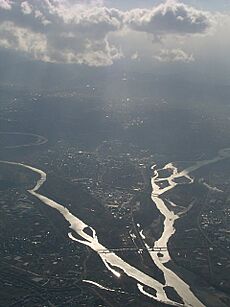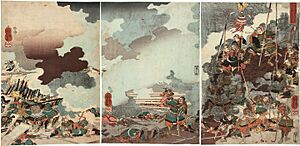Battles of Kawanakajima facts for kids
Quick facts for kids Battles of Kawanakajima |
|||||||
|---|---|---|---|---|---|---|---|
| Part of the Sengoku period | |||||||
 The Battle of Kawanakajima, Shingen on the left and Kenshin on the right; woodblock print by Utagawa Hiroshige (1845) |
|||||||
|
|||||||
| Belligerents | |||||||
| Takeda clan | Uesugi clan | ||||||
| Commanders and leaders | |||||||
|
|
||||||
| Strength | |||||||
| 4th battle: 20,000 | 4th battle: 13,000 | ||||||
| Casualties and losses | |||||||
| 4th battle: 4,000+ | 4th battle: 3,000+ | ||||||
The Battles of Kawanakajima were a series of big fights in old Japan. They happened during a time called the Sengoku period, or "Warring States Period." Two powerful leaders, Takeda Shingen and Uesugi Kenshin, fought each other. They wanted control of the Kawanakajima plain. This area is between the Sai River and Chikuma River. Today, it's part of Nagano city.
The battles started because Shingen took over Shinano Province. He forced out some local lords, Ogasawara Nagatoki and Murakami Yoshikiyo. These lords then asked Kenshin for help.
There were five main battles of Kawanakajima. They took place in 1553, 1555, 1557, 1561, and 1564. The most famous and toughest battle was on October 18, 1561. It's often just called the Battle of Kawanakajima. In the end, no one truly won control of the plain.
These battles are now famous stories in Japanese history. They show ideas of chivalry and adventure. You can find them in old books, art, and movies.
Contents
What Was the Sengoku Period?
The battles were part of the 16th-century Sengoku period. This time is also known as the "Warring States Period." It was a time of many conflicts in Japan. After a big war called the Ōnin War (1467–77), the central government lost power. The shōgun (military ruler) had less control.
Powerful local lords, called daimyōs, started to take over. They gained power in many ways. They might use war, trickery, or even marriage. Their goal was to keep their position safe. They often built strong castles on mountains, called yamajiro, to watch over their lands.
In 1541, Takeda Shingen began to conquer Shinano Province. By 1550, he took more castles. These castles belonged to Ogasawara Nagatoki, who then ran to Murakami Yoshikiyo for help. Shingen tried to take Toishi Castle. But Murakami's army fought back and almost defeated Shingen. The next year, Murakami had to leave his main castle, Katsurao. Shingen successfully took it in 1553.
The First Battle (1553)
The first battle of Kawanakajima is also called the "Battle of Fuse." It happened in 1553. It's also connected to two other battles fought nearby.
After taking Katsurao Castle, Shingen moved into the Kawanakajima plain. He marched along the eastern side of the Chikumagawa River. Uesugi Kenshin marched up the western side. He wanted to help Murakami Yoshikiyo. The two armies met near a shrine on June 3, 1553.
Shingen's army pulled back. Kenshin then tried to capture Katsura Castle, but he couldn't. In September, Shingen returned to fight the remaining Murakami forces. He took Wada and Takashima castles. Everyone in these castles was killed as a warning. Murakami Yoshikiyo left Shioda. About 16 of his outposts in Shinano gave up to Shingen. Shingen chased Yoshikyo across the Chikumagawa River. But Kenshin's soldiers stopped him at the Battle of Fuse. Kenshin then chased Shingen, winning another fight at Hachiman. Kenshin's winning army took Arato castle. Winter then forced both sides to stop fighting.
The Second Battle (1555)
The second battle of Kawanakajima is known as the "Battle of Saigawa." It took place from August to November 1555. Takeda Shingen came back to Kawanakajima. He set up camp on a hill south of the Sai River. Uesugi Kenshin camped near the Zenkō-ji temple. This spot gave him a great view of the plain.
However, the Kurita clan, who were Shingen's friends, held Asahiyama fortress. This fort was a few kilometers to the west. It threatened Kenshin's army. Kurita Kakuju's defenses were strong. He had 3,000 Takeda warriors, including 800 archers and 300 gunners.
Kenshin attacked Asahiyama fortress many times, but he was always pushed back. Eventually, he moved his army onto the plain. He focused on Shingen's main army. But instead of fighting, both armies waited for months. Each leader wanted the other to make the first move. In the end, no big battle happened. Both leaders went home to deal with problems in their own lands. A leader named Imagawa Yoshimoto helped them make peace.
The Third Battle (1557)
The third battle is also called the "Battle of Uenohara." It happened in 1557. Takeda Shingen captured a fort called Katsurayama. This fort looked over the Zenkō-ji temple. He then tried to take Iiyama castle. But he pulled back when Uesugi Kenshin led his army out of Zenkō-ji. This battle was the furthest from the Kawanakajima plain.
The Fourth Battle (1561)
The fourth battle of Kawanakajima was very bloody. Both sides lost a high percentage of their soldiers. It is one of the most interesting battles in the Sengoku period for its tactics.
Uesugi Kenshin had been fighting Hōjō Ujiyasu at Odawara castle. He had to leave when he heard rumors about Takeda Shingen's army moving. In September 1561, Kenshin left his Kasugayama Castle. He had 13,000 warriors. He wanted to destroy Shingen. He left some soldiers at Zenkō-ji. Then he took a position on Saijoyama mountain. This mountain was west of Shingen's Kaizu castle and looked down on it. Kenshin didn't know that Kaizu castle had only 150 samurai. He had surprised them completely. But the general in charge, Kōsaka Masanobu, used signal fires. He told his lord Shingen, who was 130 km away, about Kenshin's move.
Shingen left Kōfu with 16,000 men. He gathered 4,000 more as he traveled. He approached Kawanakajima on the west side of the Chikumagawa River. He kept the river between him and Saijoyama. "Neither army moved," because they knew surprise was key. Shingen was able to enter his fort at Kaizu. His army commissioner, Yamamoto Kansuke, was with him. Kansuke came up with a plan he thought would work against Kenshin.
Kōsaka Masanobu left Kaizu with 8,000 men. He climbed Saijoyama at night. His plan was to push Kenshin's army down to the plain. There, Takeda Shingen would be waiting with another 8,000 men. Shingen's army would be in a "crane's wing" formation. However, Kenshin found out about Shingen's plan. Maybe he had spies or scouts. Kenshin led his own men down to the plain instead. Kenshin's army quietly moved down the western side of Saijoyama. They used cloth to make their horses' hooves silent. At dawn, Shingen's men were surprised. Kenshin's army was ready to attack them. They were not running away from the mountain as expected.
Kenshin's forces attacked in waves. This was a "kuruma gakari" formation. It meant that fresh units replaced tired or destroyed ones. Two of Kenshin's best generals led the first attack. They were Kakizaki Kageie and Irobe Katsunaga. Kakizaki's mounted samurai fought Takeda Nobushige's unit. Nobushige was killed. Shingen's "crane's wing" formation held up well. But Takeda commanders slowly fell, one by one. Yamamoto Kansuke saw his plan had failed. He charged into the enemy ranks. He was killed in action with his two main followers.
Eventually, Kenshin's forces reached Shingen's command post. One of the most famous one-on-one fights in Japanese history happened then. Uesugi Kenshin himself burst into the headquarters. He attacked Takeda Shingen. Shingen was not ready for this. He used his signaling fan to block Kenshin's attacks. He held Kenshin off long enough for one of his men to spear Kenshin's horse. This made Kenshin ride away.
The main Takeda army stayed strong. This was despite Kenshin's fierce, rotating attacks. Obu Saburohei fought back against Kakizaki's samurai. Anayama Nobutada defeated Shibata Harunaga. He forced Kenshin's main army back to the Chikumigawa River.
Meanwhile, Kosaka's stealth force reached the top of Saijoyama. They found Kenshin's position empty. They quickly rushed down the mountain to the fort. They took the same path they thought Kenshin's army would use to escape. After a desperate fight, they broke through 3,000 of Kenshin's warriors. These warriors were defending the river crossing. They were led by Kenshin's general Amakasu Kagemochi. Kosaka's force then attacked Kenshin's retreating army from behind. Many of Takeda Shingen's great generals were killed. This included his younger brother Takeda Nobushige.
Result of the Fourth Battle
It is said that Kenshin's army lost 62% of its soldiers. Shingen's army lost 72%. Old records suggest Shingen's army did not try to stop Kenshin's army from leaving. Kenshin's army burned their camp at Saijoyama. Then they went back to Zenkō-ji and then to Echigo Province. Some people think the losses were closer to 20% for both sides.
The Fifth Battle (1564)
In September 1564, Shingen and Kenshin met for the fifth time. This battle is also known as the "Battle of Shiozaki." Their armies fought small skirmishes for 60 days. Then, both leaders decided to pull back their forces.




